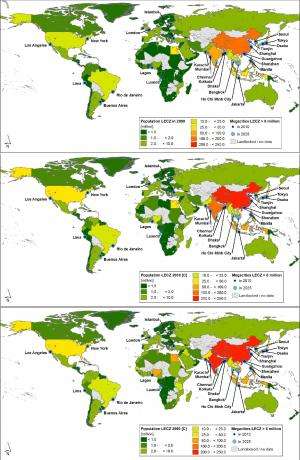Rapid coastal population growth may leave many exposed to sea-level rise

The number of people potentially exposed to future sea level rise and associated storm surge flooding may be highest in low-elevation coastal zones in Asia and Africa, according to new projections published March 11, 2015 in the open-access journal PLOS ONE by Barbara Neumann from Kiel University, Germany, and colleagues.
Many coastal areas are densely populated and exposed to a range of coastal hazards, including sea level rise. As coastal population density and urbanization continue to increase, researchers are investigating how coastal populations may be affected by potential environmental impacts at global and regional scales in the future. Based on four different sea-level and socioeconomic scenarios, the authors of this study assessed future population changes by the years 2030 and 2060 in the low-elevation coastal zone and estimated trends in exposure to 100-year coastal floods.
From the scenario-based projections, the researchers estimated that the number of people living in the low-elevation coastal zone, as well as the number of people exposed to flooding from 100-year storm surge events, was highest in Asia. China, India, Bangladesh, Indonesia, and Viet Nam had the largest numbers of coastal population per country and accounted for more than half of the total number of people living in low-elevation coastal zones, both now and in the future scenarios. However, Africa was estimated to experience the highest future rates of population growth and urbanization in the coastal zone, particularly in Egypt and sub-Saharan countries in West and East Africa.
While the authors' research method does not explicitly consider possible population displacement or out-migration due to factors such as sea level rise, the results highlight countries and regions with a high degree of potential exposure to coastal flooding, and also help to identify regions where policies and adaptive planning for building resilient coastal communities are essential.
More information: Neumann B, Vafeidis AT, Zimmermann J, Nicholls RJ (2015) Future Coastal Population Growth and Exposure to Sea-Level Rise and Coastal Flooding - A Global Assessment. PLoS ONE 10(3): e0118571. DOI: 10.1371/journal.pone.0118571
Journal information: PLoS ONE
Provided by Public Library of Science

















